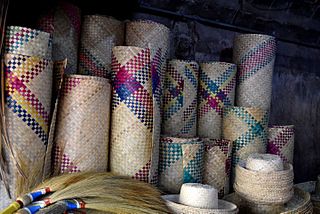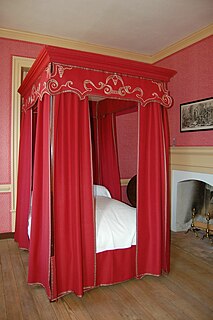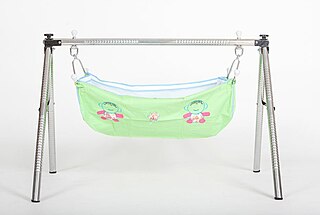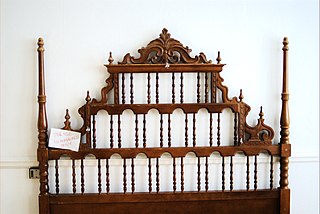 W
WA bed is a piece of furniture which is used as a place to sleep, relax, or engage in sexual activities.
 W
WAn air mattress is an inflatable mattress or sleeping pad.
 W
WA baníg is a handwoven mat usually used in East Asia and the Philippines for sleeping and sitting. This type of mat is traditionally made in the Philippines.
 W
WA bassinet, bassinette, or cradle is a bed specifically for babies from birth to about four months. Bassinets are generally designed to work with fixed legs or casters, while cradles are generally designed to provide a rocking or gliding motion. Bassinets and cradles are distinguished from Moses baskets and carry cots, which are designed to be carried and sit directly on the floor or furniture. After four months, babies are often transferred to a crib or cot. In the United States, however, the bedside sleeper is the prevalent option, since they are generally bigger, recommended up to 6 months, and often used up to a year.
 W
WA bed base, sometimes called a foundation, is the part of a bed that supports the mattress. The bed base is itself held in place and framed by the bedstead. In the United States, box-spring bed bases are very common. In Europe, sprung slats are much more common.
 W
WA bed frame or bedstead is the part of a bed used to position the mattress and base (foundation), and may include means of supporting a canopy above. Bed frames are typically made of wood or metal. A bed frame includes head, foot, and side rails. It may also include slats to support the mattress, in which case a separate base is not necessary, as in a platform bed. Most double (full) sized beds, along with all queen and king size beds, require some type of center support rail, typically also with extra feet extending down to the floor. The term "bed frame" was first used in 1805-1815.
 W
WBed rest, also referred to as the rest-cure, is a medical treatment in which a person lies in bed for most of the time to try to cure an illness. Bed rest refers to voluntarily lying in bed as a treatment and not being confined to bed because of a health impairment which physically prevents leaving bed. The practice is still used although a 1999 systematic review found no benefits for any of the 17 conditions studied and no proven benefit for any conditions at all, beyond that imposed by symptoms.
 W
WStandard bed sizes are based on standard mattress sizes, which vary from country to country. Bed sizes also vary according to the size and degree of ornamentation of the bed frame. Dimensions and names vary considerably around the world, with most countries having their own standards and terminology. In addition, two mattresses with the same nominal size may still have slightly different dimensions, due to manufacturing tolerances, amount of padding, and support type. While beds are generally rectangular, more specialized shapes may be obtained by special order, such as circular beds. Mattress sizes may differ from bedding sizes.
 W
WBed-making is the act of arranging the bedsheets and other bedding on a bed, to prepare it for use. It is a household chore, but is also performed in establishments including hospitals, hotels, and military or educational residences. Bed-making is also a common childhood chore.
 W
WThe bedding ceremony refers to the wedding custom of putting the newlywed couple together in the marital bed before numerous witnesses, thereby completing the marriage. In most traditions the newlyweds were put in bed by their family, friends, and neighbors.
 W
WA berth is a bed or sleeping accommodation on vehicles. Space accommodations have contributed to certain common design elements of berths.
 W
WA box-bed is a bed enclosed in furniture that looks like a cupboard, half-opened or not. The form originates in western European late medieval furniture.
 W
WA bunk bed is a type of bed in which one bed frame is stacked on top of another, allowing two or more beds to occupy the floor space usually required by just one. They are commonly seen on ships, in the military, and in hostels, dormitories, summer camps, prisons, and the like.
 W
WA cage bed, also known as enclosure bed or veil bed, is a bed with either metal bars or netting designed to restrain a person of any given age within the boundaries of the bed. They are most commonly used with the mentally impaired or demented patients who are likely to get out of bed without warning.
 W
WA camp bed, or cot in North America, is a small portable, lightweight bed used in situations where larger permanent beds cannot be used. The main advantage of this bed is its portability and compactness. Camp beds are generally used by armies or organizations, in tourism, and in emergency situations when there is a need to quickly provide accommodation for victims.
 W
WA canopy bed is a decorative bed somewhat similar to a four-poster bed. A typical canopy bed usually features posts at each of the four corners extending four feet high or more above the mattress. Ornate or decorative fabric is often draped across the upper space between the posts and a solid swath of cloth may create a ceiling, or canopy directly over the bed.
 W
WA bed is a piece of furniture which is used as a place to sleep, relax, or engage in sexual activities.
 W
WA bed is a piece of furniture which is used as a place to sleep, relax, or engage in sexual activities.
 W
WCharpai, Charpaya, Charpoy, Khat or Manji is a traditional woven bed used across South Asia. Regional variations are found in Afghanistan and Pakistan, North and Central India, Bihar and Myanmar. It is also known as khaat, khatia, or manji, and as manjaa in Punjab.
 W
WA cradle is an infant bed which rocks but is non-mobile. It is distinct from a typical bassinet which is a basket-like container on free-standing legs with wheels. A carbonized cradle was found in the remains of Herculaneum left from the destruction of the city by the eruption of Mount Vesuvius in 79 CE.
 W
WDaybeds are used as beds as well as for lounging, reclining, and seating in common rooms. Their frames can be made out of wood, metal or a combination of wood and metal.
 W
WEve Sleep Plc , is a UK-based e-commerce business that sells mattresses online. It was founded in 2014 and launched to the public in December 2014.
 W
WA four-poster bed is a bed with four vertical columns, one in each corner, that support a tester, or upper panel. This tester or panel will often have rails to allow curtains to be pulled around the bed. There are a number of antique four-poster beds extant dating to the 16th century and earlier; many of these early beds are highly ornate and are made from oak. An example of such an early 16th-century four-poster resides in Crathes Castle, which was made for the original castle owners in the Burnett of Leys family.
 W
WFuton (布団) is the Japanese traditional style of bedding.
 W
WA ghodiyu is an infant cradle formed of a wooden frame and a cloth hammock (jholi).
 W
WThe Golden Bed is a bed designed by the English architect and designer William Burges in 1879 for the guest bedroom of the home that he designed for himself in Holland Park, The Tower House. It is now in the collection of the Victoria & Albert Museum (V&A) in South Kensington. The bed was made by John Walden and carved by Thomas Nicholls. The painting in the central panel of the headboard was executed by Henry Holiday, and the motifs and figures on the bed painted by Fred Weekes. The bed is made from polished hardwood, mahogany and pine.
 W
WThe Great Bed of Ware is an extremely large oak four poster bed, carved with marquetry, that was originally housed in the White Hart Inn in Ware, England. Built by Hertfordshire carpenter Jonas Fosbrooke about 1590, the bed measures 3.38m long and 3.26m wide and can 'reputedly... accommodate at least four couples'. Many of those who have used the bed have carved their names into its posts.
 W
WA hammock is a sling made of fabric, rope, or netting, suspended between two or more points, used for swinging, sleeping, or resting. It normally consists of one or more cloth panels, or a woven network of twine or thin rope stretched with ropes between two firm anchor points such as trees or posts. Hammocks were developed by native inhabitants of the Americas for sleeping, as well as the English. Later, they were used aboard ships by sailors to enable comfort and maximize available space, and by explorers or soldiers travelling in wooded regions. Eventually, in the 1920s, parents throughout North America used fabric hammocks to contain babies just learning to crawl. Today they are popular around the world for relaxation; they are also used as a lightweight bed on camping trips. The hammock is often seen as a symbol of summer, leisure, relaxation and simple, easy living.
 W
WHammock camping is a form of camping in which a camper sleeps in a suspended hammock rather than a conventional tent on the ground. Due to the absence of poles and the reduced amount of material used, they tend to be significantly lighter than a tent. Their reduced weight often results in less space inside than a similar occupancy tent. In foul weather, a tarp is suspended above the hammock to keep the rain off of the camper. Mosquito netting, sometimes integrated into the camping hammock itself, is also used as climatic conditions warrant. Camping hammocks are used by campers who are looking for lighter weight, protection from ground-dwelling insects, or other ground complications such as sloped ground, rocky terrain and flooded terrain.
 W
WHästens Sängar AB, doing business as simply Hastens, is a Swedish manufacturer established in 1852, today specializing in beds, bedlinen, pillows and lifestyle accessories.
 W
WThe headboard is a piece of furniture that attaches to the head of a bed. Historically, they served to isolate sleepers from drafts and cold in less insulated buildings, and thus were made of wood, which is less thermally conductive than stone or brick. Constructed to create space from the wall they allowed falling colder air to sink to the floor rather than onto the bed.
 W
WA hospital bed or hospital cot is a bed specially designed for hospitalized patients or others in need of some form of health care. These beds have special features both for the comfort and well-being of the patient and for the convenience of health care workers. Common features include adjustable height for the entire bed, the head, and the feet, adjustable side rails, and electronic buttons to operate both the bed and other nearby electronic devices.
 W
WAn infant bed is a small bed especially for infants and very young children. Infant beds are a historically recent development intended to contain a child capable of standing. The cage-like design of infant beds restricts the child to the bed. Between one and two years of age, children are able to climb out and are moved to a toddler bed to prevent an injurious fall while escaping the bed.
 W
WThis is a list of countries by hospital beds per 1000 or 100,000 people, as published by the local governments, international organisation, academic sources or others. The number of beds per people is an important indicator of the health care system of a country. The basic measure focus on all hospital beds, which are variously split and occupied. The classic hospital beds are also called curative beds. For severe patients with risk of organ(s) failure, patients are provided intensive care unit beds or critical care beds (CCB).
 W
WThe Lit à la Turque, a bed with two scrolling ends and a baldachin, was one of many products of the 18th century. Due to the obsession with anything exotic or unusual from foreign countries; beds, furniture and other objects reflected this style. The design of this bed is not directly linked with any Turkish design, but reflects the luxurious and romantic designs that inspired the craftsmen of this time.
 W
WThe marriage bed of Henry VII was a bed designed and built for use on the night of his marriage to Elizabeth of York on 18 January 1486. The marriage symbolised the end of the War of the Roses by joining Henry's House of Lancaster to Elizabeth's House of York and the bed's design reflected this featuring both the White Rose of York and the Red Rose of Lancaster. A carving on the headboard depicted the Royal couple as either Adam and Eve or Christ and the Virgin Mary defeating the animals that opposed Christ in Psalm 91 and bringing paradise to England. The bed also includes the arms of France, reflecting Henry's possessions and ambitions there, as well as religious and fertility symbols.
 W
WA Murphy bed, also called a wall bed, pull down bed, or fold-down bed, is a bed that is hinged at one end to store vertically against the wall, or inside a closet or cabinet.
 W
WMy Bed is a work by the English artist Tracey Emin. First created in 1998, it was exhibited at the Tate Gallery in 1999 as one of the shortlisted works for the Turner Prize. It consisted of her bed with bedroom objects in a dishevelled state, and gained much media attention. Although it did not win the prize, its notoriety has persisted. It was sold at auction by Christie’s in July 2014 for £2,546,500.
 W
WA Polish bed, alternatively known in English as a polonaise, is a type of canopy bed draped with a baldachin, which originated in 18th-century Poland. The curtain is topped with an elaborate crownlike centrepiece that is connected to the four corner posts of the bed frame that are usually curved. Historically, a Polish bed was placed on its side against the wall to serve as a daybed. Nowadays, any type of curtained daybed or couch is known under this term.
 W
WA sleigh bed is a style of bed with curved or scrolled foot and headboards, thus resembling a sled or sleigh.
 W
WA sofa bed or sofa-bed is typically a sofa or couch that, underneath its seating cushions, hides a metal frame and thin mattress that can be unfolded or opened up to make a bed. A western-style futon differs from a sofabed, although sofa beds using futon mattresses are common.
 W
WA stretcher, litter, or pram is an apparatus used for moving patients who require medical care. A basic type must be carried by two or more people. A wheeled stretcher is often equipped with variable height frames, wheels, tracks, or skids. Stretchers are primarily used in acute out-of-hospital care situations by emergency medical services (EMS), military, and search and rescue personnel. In medical forensics the right arm of a corpse is left hanging off the stretcher to let paramedics know it is not a wounded patient. They are also used to hold prisoners during lethal injections in the United States.
 W
WA Tapchan (топчан) is a type of outdoor furniture unique to Central Asia especially Tajikistan and Uzbekistan, combining a large bed capable of holding 4-8 adults with a table at which meals can be eaten.
 W
WThe Red Bed is a piece of painted furniture designed by the English architect and designer William Burges made between 1865 and 1867. Built of mahogany, painted blood red and decorated with imagery of the Sleeping Beauty fairy tale, it was made for Burges's rooms at Buckingham Street, and later moved to his bedroom at The Tower House, the home he designed for himself in Holland Park. Burges wanted to fill his home with furniture covered with paintings, both ornaments and subjects; it not only did its duty as furniture, but spoke and told a story. Burges died in the bed, aged 53, on 20 April 1881.
 W
WA trundle bed is a low, wheeled bed that is stored under a twin/single bed and can be rolled out for use by visitors or as just another bed.